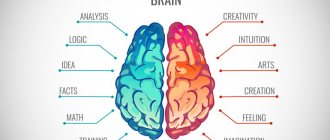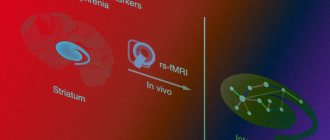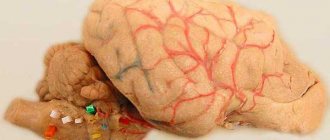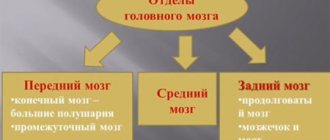basic information
At the very beginning, it is worth saying that the human brain consists of two hemispheres - the right and left. These parts are separated by the cerebral cortex, but information exchange occurs through the so-called corpus callosum. To illustrate the work of both hemispheres, we can draw a fairly simple analogy with a computer. So, in this case, the left side of the brain is responsible for sequential execution of tasks, i.e. it is the main processor. The right hemisphere can perform several tasks simultaneously, and it can be compared to an additional processor that is not the master.
Amazing Brain Powers
However, this is not the first surprising case. There are many other cases in the literature about the brain's ability to adapt to unexpected situations. Thus, one boy had a third of his right hemisphere removed, including the part of the brain responsible for vision. But several years after the surgery, neuroscientists discovered that the left side of his brain had begun to take over the visual functions of the missing left side, and he could still see perfectly, Live Science reported. Another study, published in the journal Neuron, looked at a small group of women who could smell despite lacking the olfactory bulb, the area at the front of the brain that processes smell information. While it's still a mystery how exactly this happens, researchers believe that perhaps another part of the brain has taken over the task of processing smells.
The authors of the new study hope to be able to better understand how the brain reorganizes itself after injury or stroke and how certain areas of the brain compensate for those lost or damaged. Perhaps, ultimately, thanks to this work, scientists will be able to help a large number of people suffering from the consequences of injuries and various brain diseases.
The work of the hemispheres
In short, the left hemisphere of the brain is responsible for analysis and logic, while the right hemisphere is responsible for images, dreams, fantasies, and intuition. In each person, both parts of this organ should function evenly, however, one of the hemispheres will always work more actively, and the other as an auxiliary element. From this we can draw a simple conclusion that creative individuals have a more developed right hemisphere of their brain, while business people have a more developed left hemisphere. Let's take a closer look at what functions the left hemisphere of the brain performs.
Difference between the left and right hemispheres of the brain
The functions of the brain are divided in a remarkable way. For example, approximately 95% of all adults use the left hemisphere for language (speaking, writing, and understanding). In addition, the left hemisphere has superiority in mathematics, timing and rhythm, and coordinating the order of complex movements such as those required for speech.
In contrast, the right hemisphere responds only to simple language and counting. Working with the right side of the brain is like talking to a child who only understands a dozen words. To answer questions, the right hemisphere must use nonverbal responses, such as pointing at objects.
Although the right side of the brain is weak in language, it has its own talents, especially perceptual skills. During the test, the right hemisphere is better at recognizing patterns, faces and melodies, solving design problems or drawing a picture. It is also involved in recognizing and expressing EMOTIONS.
About people
What can be generally said about people whose left hemisphere of the brain is more active and developed? Thus, such individuals are organized, they love order, and always comply with all deadlines and schedules. They easily perceive information by ear and almost always reach their goal, since their actions are subject to common sense, and not to impulses of the soul. However, it cannot be said about such individuals that art is alien to them. Not at all, but in creative activity these people will choose what has form and meaning, abandoning abstraction and understatement.
Necessary conditions for child brain development
Nature has provided the human brain with a huge number of neurons that make up its core. Their diverse connections provide consciousness, thinking, memory, coordination and functioning of the entire organism. It is their formation that ensures the development of the brain.
The active process occurs until the child is three years old, after which the rate of development decreases significantly. Full physiological formation is completed by the age of 6-7, when a person is completely ready to perceive information, analyze it and conscious mental activity.
Researchers identify the following important factors influencing brain development:
- Speech. Verbal information received by the child becomes the main stimulant. The earlier and more language exposure an infant receives, the faster the brain develops. Verbal information stimulates the formation of connections for processing incoming information. It is important to understand that it is impossible to utter any word without hearing it at least once. Parental speech establishes vocabulary and communication skills in the first 2-3 years after birth.
- Stability and stress. The baby's brain instantly reacts to any external stimuli. A stable, calm environment provides normal conditions for development. Stresses that generate internal irritants become depressing factors for him. The child’s brain completely switches to such influences. Prolonged stressful situations lead to the production of cortisol and other dangerous hormones that change the entire brain structure.
- Emotions. Positive emotions in a child contribute to normal brain development. The caring attitude of parents and a favorable external environment create the basis for the formation of a response to future learning. It establishes trust and the necessary relationships between the baby and adults.
- Praise. Research has shown that praising a child's efforts between the ages of 1 and 3 stimulates a desire to broaden his or her horizons in the future. It is important to understand that rewarding diligence, not praising innate talents, has a positive effect.
- Cry. It has been established that the lack of response to a baby's crying disrupts normal brain development, increasing the impact of harmful stress. Parents' attention to their baby's crying lays the foundation for trust and affection.
There is considerable debate about the impact of television on a child's brain development. Most psychologists agree that it cannot be considered an assistant in this important process. Television information is practically not deposited in the infant brain. At the same time, the same information heard from the mother’s lips is absorbed well.
About development
People are often interested in the question of how to develop the left hemisphere of the brain. It is worth saying that this can be done. It’s enough just to periodically train your “computer”. So, the following exercises may be useful for this:
- Physical activity on the body is closely related to brain function. If you spend more time developing the right half of the body, the left hemisphere of the brain will work more actively.
- Since the left hemisphere of the brain is responsible for logic and solving mathematical problems, you need to devote more time to this activity. You need to start with simpler mathematical exercises, gradually raising the bar. The activity of this hemisphere will undoubtedly lead to its further development.
- A fairly simple tip on how to develop the left hemisphere of the brain is to solve crossword puzzles. In this case, a person most often acts analytically. And this leads to the activation of the left half of the brain.
- And, of course, you can select specialized tests developed by psychologists that help activate and develop the desired hemisphere of the human brain.
Spheres of influence of the cerebral hemispheres
The main functions of the left hemisphere are logical thinking and speech. The left hemisphere is focused on working with numbers and letters.
The left hemisphere determines the following human abilities:
- logical information processing;
- analytical thinking: analysis of facts, recognition of written characters and symbols;
- mathematical abilities: solving mathematical problems, recognizing mathematical symbols and numbers;
- reading ability: recognizing letters, understanding the literal meaning of words;
- writing ability;
speech and control over it;- ability to learn foreign languages.
The main functions of the right hemisphere are imaginative thinking and intuition. The right hemisphere focuses on images and emotions.
The right hemisphere determines the following human abilities:
- figurative perception and processing of all information at once, in its entirety, the ability to perceive the totality of something as a single image;
- processing of non-verbal signals: understanding of non-verbal information coming in the form of images and symbols, body signals both from outside and from inside the human body;
- orientation in space: the ability to determine one’s location and the position of objects in space;
- creative abilities: music, drawing, poetry and others;
- understanding the meaning of words and metaphors;
- imagination: the ability to imagine, dream, fantasize and understand the results of another person’s imagination;
- emotional perception (although another part of the brain is responsible for the emotional sphere of a person, the right hemisphere connects it to the process of perceiving the world);
- the ability to perceive and believe in irrational phenomena.
Harmonious work
It should also be mentioned that both hemispheres of the brain need to be developed simultaneously. After all, only a diversified person is talented, more competitive in the labor market and unique in his capabilities. Moreover, there are people who are called ambidextrous. Both hemispheres of their brain are equally developed. They can perform all actions equally well with both their right and left hands. Such people do not have a pronounced, leading hemisphere; both parts of the brain are involved in the work equally. This state can be achieved through hard work and training.
Harmony comes first
In early childhood, both hemispheres are usually equally developed, but subsequently, in almost everyone except left-handed people, the left one dominates. Therefore, the development of the left hemisphere is not as important as the right. Moreover, both in kindergartens and schools they pay attention to the development of children's analytical abilities.
The task of parents is to make efforts for the harmonious development of both hemispheres in the child, developing them in parallel, so that in the future, in accordance with a given situation, he can activate what is needed.
Excessive development of the left leads to a person’s lack of creative and creative abilities, and the right leads to difficulties with concentration, consistency of actions, determination and implementation of ideas.
However, in case of dysfunction of the left hemisphere, special attention should be paid to it.
Cause of pain
It happens that a person’s left hemisphere of the brain hurts. Why is this happening? The most common cause is migraine. In this case, the pain is localized precisely on the left side of the head. The duration of this condition also varies – from several hours to a couple of days. Among the main causes of this condition, scientists identify the following:
- Physical fatigue.
- Stress.
- Heat and dehydration.
- Tension of the falciform septum of the brain.
- Diseases of the trigeminal nerve, its inflammation.
- Insomnia.
However, if a person periodically has pain in the left hemisphere of the brain, it is still worth seeking medical advice. After all, this symptom is not always harmless. Often, headaches in a certain part of the head indicate tumors, thrombosis or other serious problems that can threaten not only the health, but also the life of the patient.
Development of thinking is the main condition for success
First of all, in order to become a thinking person and thanks to this succeed in life, you need to change your thinking. How do successful people think? They believe that a change in mindset is necessary to achieve their goals. By changing thinking, making it more fruitful, getting rid of stereotypes and finding new approaches, a person consistently changes:
- Beliefs;
- Expectations;
- Life position;
- Behavior;
- Performance;
- Life.
You can start changing your thinking with the harmonious development of the brain hemispheres. Psychologists have developed a set of exercises for this. Most of them are aimed at developing hands. Music classes are recommended (pianists are forced to develop both hands equally), asynchronous sports exercises (we draw a circle in the air with our right hand, a square with our left, or try to draw identical pictures with both hands simultaneously), neuro-linguistic programming techniques.
If the left hemisphere “sags,” solving crossword puzzles, learning foreign languages, and playing chess will help. If there is not enough activity in the right hemisphere, right-handed people should start doing everyday things with their left hand, develop visualization, and train tactile sensations. As you can see, you can develop your brain abilities on your own, but this requires perseverance and patience.
If you want your children to be able to think more productively, you need to put a lot of effort into developing their thinking patterns. This will definitely help, sooner or later you will notice that their thought process has changed, and this helps you change your life. Developed thinking in modern society is a determining factor of success. Almamat, as the first online STEM school in Russia, can offer your children a practical and fun approach to training and developing the “left hemisphere”. A modular individual approach to the formation of effective programs for the development of thinking is aimed at accelerating the thinking process, improving analytical abilities, and developing critical thinking. We strive to lead your children away from patterns and stereotypes to the skills and professions of the future. All this will help your child become a thinking and successful person!
Hemorrhagic stroke
Hemorrhagic stroke is intracerebral hemorrhage. What happens to a person in this case? What consequences can a hemorrhage in the left hemisphere of the brain have?
- Movement disorders. If the hemorrhage occurs on the left side of the brain, the right side of the patient's body will be affected first. Difficulties may arise when walking and coordinating. Unilateral movement disorders are medically called hemiparesis.
- Speech impairment. As mentioned above, it is the left hemisphere of the brain that is responsible for the perception of symbols and numbers, as well as reading and writing. When a hemorrhage occurs in this particular part of the brain, a person begins to have difficulty not only speaking, but also perceiving the words of others. There are also problems with writing and reading.
- Processing information. In case of hemorrhage on the left side of the head, a person stops thinking logically and processing information. Understanding becomes inhibited.
- Other symptoms not related to the activity of the left hemisphere. These may be pain, psychological disorders (irritability, depression, mood swings), problems with bowel movements and urination.
Disability after hemorrhage is high and accounts for approximately 75% of all cases. If the cause of this problem is not determined in time, repeated hemorrhage is possible, which can even lead to the death of the patient.
Lingua Bona®
STATE OF INTRA- AND INTERHEMISPHERE CONNECTIONS OF THE BRAIN
IN CHILDREN WITH MOTOR DYSPHASIA
ACCORDING TO COHERENT ANALYSIS OF ELECTROENCEPHALOGRAPHY
Anisimov G.V., Savelyeva N.A.
CONDITION OF COMMUNICATIONS IN HEMISPHERES AND BETWEEN HEMISPHERES OF THE BRAIN AT CHILDREN WITH THE MOTOR DYSPHASIA ACCORDING TO ELEKTROENTSEFALOGRAFIYA'S COHERENT ANALYSIS Anisimov GV, Savelyeva NA Perm State Medical Academy, Department of Neurology, Pediatric Faculty, Perm First Medical-Pedagogical, Perm m. Speech occupies a special position in a number of cognitive functions, which serves as a means of “vocalization” of voluntary mental activity, and on the other hand, it itself is the basis for the development of the cognitive sphere. Therefore, a delay in the rate of speech development, in particular motor dysphasia (MD), can lead to dysontogenesis of higher mental functions [1,2,5,6,7].
One of the aspects of the pathogenesis of MD is the morphofunctional immaturity of connections and disconnection between brain areas involved in the formation of speech in a child [2,8]. Along with clinical, neuropsychological and speech therapy methods for examining children with MD, the introduction into clinical practice of modern quantitative methods for assessing electroencephalography (EEG) will make it possible to clarify the brain mechanisms of speech disorders and objectively assess the effectiveness of treatment and correction measures.
One of the methods for quantitative EEG processing is coherence analysis. Coherence is a measure of synchronization between two different scalp leads and, from a functional point of view, reflects the degree of spatiotemporal relationships or the state of functional integration of neurons in anatomically related structures that generate discharges synchronously [4]. Unfortunately, the method has not yet found proper clinical application. There are insufficient studies comparing clinical and neuropsychological syndromes with the results of EEG coherence analysis. This makes it difficult to interpret the results obtained for daily medical practice and the active use of the method.
The purpose of our study was to study the functional integration of various brain areas in children with motor dysphasia using coherent EEG analysis.
We observed 18 children, of which 6 girls (33.3%) and 12 boys, aged 2 years 9 months - 3 years 6 months (average age 3 years 2 months) with a diagnosis of motor dysphasia. The diagnosis was made based on medical history, neurological and neuropsychological status, and examination by a speech therapist. Phrasal speech was absent, there were onomatopoeia and babbling words, the children used non-verbal means of communication when following instructions.
The leading neuropsychological syndromes in children were kinesthetic and dynamic dyspraxia, impaired reciprocal coordination, and partial left-handedness.
EEG recording was carried out using the Neuronspectr – 4/VP software and hardware complex. The electrodes were placed on the head according to the standard 10-20 pattern. The average coherence (MC) was determined in the range from 2 to 20 Hz, which is expressed in coefficient values from 0 to 1. The higher the coherence value, the more significant the connection of a given point of the brain with another chosen for measurement. To assess the level of intrahemispheric integration along the average cortico-cortical pathways, we used pairs of leads with an average distance (FP1-C3, FP2-C4, C3-O1, C4-O2, FP1-T3, FP2-T4, T3-O1, T4-O2 ). Interhemispheric pairs included short (FP1-FP2, F3-F4, C3-C4, P3-P4, O1-O2) and long (F7-F8 T3-T4 T5-T6). In addition to analyzing the level of spatiotemporal relationships (integration) according to SC data, we determined the anteroposterior ratio of coherence values in both hemispheres Fp-C/CO and Fp-T/TO, as well as the degree of coherence asymmetry in frontotemporal pairs (FP1-T3, FP2 -T4). The results obtained were compared with the SC indicators of healthy children of the same age presented in the monograph by L.B. Ivanov. [4]. SC calculations in healthy children were carried out in the same range and using the same pairs of electrodes.
In the ontogenesis of a child, by the age of three, typical spatio-temporal relationships are formed according to coherent analysis of EEG, characteristic of age groups 4-15 years [4]. There is a significantly high functional integration of the poles of the frontal lobes (maximum in the FP1-FP2 pair) with a minimum in the interoccipital, intertemporal and interparietal pairs (Table 1)
Analysis of the SC results for interhemispheric pairs of electrodes indicates high SC values in general in the group of children with MD compared to healthy children. The indicators were low-variable and monotonous. Compared with the parameters of healthy children, there was a significant increase in SC in the central, parietal and occipital regions (Table 1).
When analyzing SC values in long interhemispheric pairs in the observation group, an excessive level of intertemporal integration was revealed (a 2-fold increase in the indicator compared to healthy children). Increased interparietal integration, according to some researchers, can be combined with motor disinhibition, which often accompanies the clinical picture of children with MD, and high intertemporal coherence indicates emotional dysfunctions [3, 4].
Intrahemispheric functional integration of cortical zones normally assumes a maximum SC value in the frontal regions with a decrease in the indicator towards the occipital pairs of electrodes.
When analyzing intrahemispheric spatiotemporal relationships in children with speech desontogenesis, a significant increase in the level of coherence in the central-occipital and temporo-occipital pairs of both hemispheres was revealed with normal integration in the fronto-central and frontotemporal pairs (Table 2). This circumstance can be compared with the developmental characteristics of children with MD. Such patients, against the background of a disorder of motor speech formation, often have early mastery of the skills of comparing a phoneme with the corresponding optical image of a letter. This phenomenon can be considered as the development of compensation/hypercompensation in the parieto-temporo-occipital
areas (angular gyrus) against the background of a speech defect, and normal integration in the frontotemporal and frontocentral pairs (arcuate fasciculus) can serve as a favorable sign of the appearance of expressive speech with appropriate medical and pedagogical correction.
Table 2. Indicators of average coherence for intrahemispheric pairs (M±m)
Table 3. Anteroposterior ratio of average EEG coherence indicators for intrahemispheric pairs
The indicators of the anteroposterior ratio of SC values in children with MD, as shown by comparison with the indicators of healthy people, turned out to be more indicative than the interhemispheric and intrahemispheric parameters themselves
SC (Table 3). The anteroposterior ratio through the temporal regions turned out to be the lowest, 1.1, while the norm was 3.1. This ratio (Fp-T/TO) can be used in the dynamics of the disease to assess the effectiveness of therapy.
According to Ivanov L.B. in the first two years, healthy children have asymmetry of coherence with dominance of pairs of leads of the right hemisphere with periods of absence of asymmetry. From the age of three, the degree of asymmetry in fronto-temporal pairs (FP1-T3, FP2-T4) lateralizes towards the left pairs and can reach 20%. In the observation group, coherence asymmetry in frontotemporal pairs tended towards the right leads (FP1-T3/FP2-T4 = 0.502/0.515= 2.5), which is consistent with the neuropsychological data of the predominance of right hemispheric functional asymmetry in children with MD (hidden left-handedness or ambidexterity) against the background of insufficient functional activity of the left hemisphere, which normally has a decisive role in the implementation of speech functions [2,5,6].
Coherence analysis allows us to determine the temporal-spatial relationships between different areas of the brain and can be used as an objective criterion for the adequacy of the therapy. In children with motor dysphasia, the following was noted: a shift of maximum interhemispheric integrations to the central and especially interparietal, intertemporal leads; decrease in the anteroposterior ratio index, especially through the temporal regions; shift of coherence asymmetry to the right leads or excessive asymmetry of the left hemisphere. Violation of interzonal connections of the temporal (phoneme formation) with the parietal-frontal (articulome formation) regions does not allow the child to acquire an integrative word. On the other hand, there is overcompensation in the parietal-temporo-occipital region and interparietal integration, manifested by hyperdynamic syndrome, non-verbal means of communication, advanced mastery of written language, which are protective (compensatory) reactions of the brain, preserving the normal intellectual development of the child.
The identified features, in comparison with the clinical picture, not only reflect the levels of disintegration of the activity of various zones of the cerebral cortex, but can help to identify electrophysiological markers that determine the prognosis of the disease. The development of a child is based on brain plasticity, which is ensured by the large volume and mobility of interzonal brain connections, which allows the use of the quantitative EEG method to monitor clinical symptoms, the correctness and adequacy of the complex of therapeutic and corrective measures.
Literature
1. Wiesel T.G. Fundamentals of neuropsychology. – M.: Astrel, 2005.
2. Wiesel T.G. The significance of hemispheric interaction processes in the pathogenesis of speech disorders // Asymmetry - 2010. - No. 4. – P. 9-21.
3. Dakhaeva L.N. Computer neuromapping of the brain in Gilles de la Tourette syndrome in children: abstract. ...cand. medical sciences – M., 1998. – 19 p.
4. Ivanov L.B. Applied computer electroencephalography. – M: Antidor, 2004. – 256 p.
5. Cognitive disorders in children: textbook / Yu.I. Kravtsov [and others] // State Educational Institution of Higher Professional Education PGMA named after. ak. E.A. Wagner Roszdrav. – Perm, 2010. – 122 p.
6. Lokhov M.I., Fesenko Yu.A., Rubin M.Yu. Bad good child. Developmental problems, behavioral disorders, attention, writing and speech. – St. Petersburg: ELBI-SPb, 2003. – 320 p.
7. Lukashevich I.P., Partsalis E.M., Shklovsky V.M. Perinatal risk factors for the development of speech pathology in children // Journal.
Russian Bulletin of Perinatology and Pediatrics. – 2008. – T. 53, No. 4. – P.19-22
8. Shepovalnikov A.N., Tsitseroshin M.N. Formation of interregional interaction of cortical fields during speech and mental activity // Journal. Evolutionary biochemistry and physiology. – 2004. – No. 5. – P.411-422.
ANNOTATION
Based on coherent analysis of electroencephalography, the degree of functional integration of various brain areas in children with motor dysphasia was analyzed. A shift of the maximum interhemispheric indicators of average coherence to the central and especially interparietal, intertemporal regions was demonstrated; decrease in the anteroposterior ratio index in the temporal regions; displacement of asymmetry to the right leads or excessive asymmetry of the left hemisphere. The results obtained indicate that disruption of interzonal connections of the temporal and parieto-frontal regions is the neurophysiological basis for the development of motor dysphasia. On the other hand, there is overcompensation of the parietal-temporo-occipital and interparietal regions, which is clinically manifested by hyperdynamic syndrome, the use of non-verbal means of communication, and advanced mastery of written language.
Key words: electroencephalography, motor dysphasia, coherence analysis, speech delay
Keywords: elektroentsefalografiya, motor dysphasia, coherent analysis, delay of speech development
Information about authors
1. Anisimov Grigory Vladimirovich (AnisimovGrigory) Candidate of Medical Sciences, Assistant of the Department of Neurology of the Pediatric Faculty of the Perm State Medical Academy, Director Work address 614 017. Perm, st. 25 October, no. 42, e-mail: [email protected] contact phone 8 964 190 1903
2. Savelyeva Natalya Aleksandrovna (Savelyeva Natalia), graduate student of the Department of Neurology of the Pediatric Faculty of the Perm State Medical Academy, Work address 614 017. Perm, st. 25 October, 42, e-mail, contact phone number 6
Switching off the left hemisphere
Sometimes people wonder how to turn off the left hemisphere of the brain, is it even possible to do this? The answer is simple: you can. Moreover, every person does this every day when going to bed. During sleep, it is the right hemisphere that is activated, and the left one attenuates. If we talk about the period of wakefulness, then the left hemisphere is always at work and helps people think logically and analyze the information received. It is worth saying that it is impossible to completely turn off the work of the left hemisphere during its active activity (without the intervention of special tools and psychiatrists). And there is no need to do this at all. It is best to establish a balance between the right and left hemispheres, which will make the life of an individual better and better.
Brain development: useful tips and exercises
What makes a person human? There are many answers to this question, but one of the most common and true is that a person has high self-awareness, is able to think and has a brain that is many times more developed than the brain of any other living creature known to science. Over thousands of years of evolution, the human mind and brain have undergone a huge number of significant changes, and this progress itself is based on the ability to develop. It is for this reason that people have moved their thinking to a qualitatively new level.
But it’s easy to guess that humanity as a whole, and each of us individually, has not yet reached the peak of our capabilities. This means that the brain is still constantly developing. But what is more interesting is that we are able to influence the development of our main organ independently. Moreover, it is also everyone’s responsibility, because first of all, personal life results, work efficiency, success in learning, mastering new skills and communicating with others depend on the degree of brain development.
Taking into account all of the above, today we want to talk about brain development. Next, you will learn interesting information about the human brain, its functions and developmental features, useful tips, exercises and training methods. All of this can create an effective system for developing thinking that you can use every day. To begin with, we will say a few words about the human brain as a whole in order to better understand how to develop it as much as possible.
Briefly about the human brain
The human brain is the most mysterious and enigmatic organ, and many draw an analogy between it and a computer. Throughout his life, a person learns something and learns something new, and all information that is useful to him in one way or another goes into his memory and is stored there as long as he needs it. If some data becomes irrelevant, the brain simply erases it.
The functions of the brain can be listed for a very, very long time, but the main thing is that thinking, memory, imagination, speech, feelings, perception, and self-awareness depend on it. Naturally, this list is much larger, and if you want to learn more about the human brain and its development, you can find and read specialized books (Roger Sipe, John Medina, Dmitry Chernyshev and other authors).
The brain consists of the right and left hemispheres, connected to each other by the substance callosum, which serves to transmit information between them. If one hemisphere is damaged, the second is usually damaged as well. But there are cases when, for example, when the left hemisphere was destroyed, the right hemisphere took over its functions, and vice versa, thanks to which a person could continue to live a full life. As for these same functions, they are different.
The left hemisphere is responsible for logical thinking and working with numbers. It processes and analyzes information in a specific, strict sequence. And the right hemisphere is responsible for sensory perception and creative thinking - with its help music, smells, colors, art, etc. are perceived. This same hemisphere helps a person navigate the space around him. And thanks to its ability to synthesize existing information, a person gets the opportunity to think creatively, find non-standard solutions, solve puzzles, perform all kinds of exercises and play games to develop thinking and imagination (by the way, speaking about the development of thinking, it would not be superfluous to mention the course in cognitive science, after completing which you will be able to master twelve different thinking techniques).
In principle, the information considered is more or less sufficient for an approximate understanding of how the human brain works. And it only remains to note that thanks to special exercises the brain can be developed and made more powerful. However, it is very important to pay attention to the so-called preparatory activities, because it does not matter whether the brain of a child or the brain of an adult is trained, in any case it must be prepared for this.
How to prepare your brain for training
There are three basic rules that should be taken into account in order to make your brain more elastic, pliable and ready to perceive and assimilate new information, as well as its subsequent reproduction and competent application.
These rules include:
- Elimination of physical inactivity. This means that you must provide yourself with the necessary amount of physical activity. Physical inactivity is characteristic of people who lead a passive lifestyle or simply move little, for example, those whose activities involve spending a lot of time in a sitting position, for example, schoolchildren and students, who like to play computer games for hours or who love TV. And the negative consequences of physical inactivity are expressed in the fact that it does not allow fatty acids in the body to be broken down, which leads to the formation of cholesterol plaques on the vessels that interfere with normal blood circulation. Blood provides the organs, including the human brain, with the amount of oxygen they need, and if this process is disrupted, the functions of the brain are also disrupted, as a result of which the efficiency of its work deteriorates (in particular, physical inactivity negatively affects the brain of a child and an elderly person).
- Providing the body with phosphates and carbohydrates. Here we will only say that, firstly, you need to include in your diet foods rich in phosphorus (pumpkin, wheat germ, poppy seeds, soybeans, sesame seeds, processed cheese, nuts, oats, beans and others), as well as foods high in healthy carbohydrates (rice, corn flakes, bran, pasta, kefir, milk, shrimp, fish and others). By the way, here you can read about proper nutrition. And secondly, you should minimize or completely stop drinking alcohol, which has a detrimental effect on brain neurons. In addition to harmful alcohol, alcohol contains carbon dioxide, and together with alcohol it has a very powerful destructive effect on brain cells.
- Drinking water. We have already written in detail about the benefits of water, but now let us just remind you that clean water helps the body cleanse itself of toxins and waste, and also promotes the development of cognitive abilities, supporting neural connections. To provide yourself with the optimal amount of water, you should drink a liter of water per day per 30 kg of your body weight. If you are exposed to excessive stress, then it is advisable to increase the amount of water consumed even more.
By following these three rules, you will create a serious foundation for brain training. And any development system should be based on them - the brain of a child and the brain of an adult require special “care” and attention to themselves. And a lot of useful information on the presented topic is contained in thematic books (Roger Sipe, Mark Williams and Denny Penman, Alex Lickerman and other authors).
Development of both hemispheres of the brain
Let's remember: the left hemisphere processes speech and numerical information, logic, conclusions, analysis, linearity, etc. The right hemisphere provides spatial orientation, color perception, perception of shapes, sounds, colors, rhythms, dreams, etc. In general, of course, data is perceived by both hemispheres, but each of them predominates in its own area (you can read about functional asymmetry in this article).
Hence the conclusion: by developing one hemisphere, you can, for example, “train” in the ability to perceive images and become super creative, but at the same time experience serious difficulties in solving arithmetic problems. Or, conversely, you can become a pro in analytics, but be unable to see beauty in paintings or not be able to compose a banal four-line poem.
Therefore, educational institutions often teach not only core disciplines, but also those that are completely unrelated to the specialty. Remember the same mathematicians who study literature, history and other humanities subjects, or philologists whose schedule includes technical disciplines. This serves as further evidence that both hemispheres require development. And for this you can resort to the following exercises:
Exercise 1
For the first exercise you will need a partner. Let him blindfold you with something. Once this is done, take a short walk around the room or area where you are currently located. After that, answer the following questions:
- Has the activity of your senses increased, and if so, how?
- What helped you overcome the uncertainty of not being able to see?
- What sounds do you remember?
- Was there anything that worried you?
- Was there anything that calmed you down?
Based on these answers, you will understand how the body reacts to the shutdown of one of the senses. And the exercise itself will help you activate additional resources of both hemispheres.
Exercise 2
Through the second exercise, you will learn to synchronize the work of both hemispheres of your brain. It is done like this:
- Stand up straight and extend both arms forward or up;
- Draw a circle in the air with your left hand and a square with your right;
- Perform the exercise until you succeed, and then switch hands.
This exercise can also be complicated by drawing more complex shapes in the air with your hands. And based on the idea of the same exercise, there is even a special system for the development of both hemispheres. Its meaning is to do familiar things in non-standard ways. You can, for example, wash dishes, brush your teeth or eat with the other hand, hold the phone to the other ear, carry a bag or backpack on the other shoulder (the word “other” means the left side for right-handers, and the right for left-handers).
Exercise 3
A banal and simple exercise at first glance, but in reality it perfectly helps to synchronize the work of the right and left hemispheres. This is done as follows:
- Stroke your stomach with your right hand clockwise;
- Now with your left hand, lightly tap your head with vertical movements;
- After a little practice, perform the indicated movements at the same time.
It is interesting that very often the hands themselves begin to confuse the movements: the left hand does what the right hand should, and the right hand does what the left should. The exercise is very interesting, and after the first option is mastered, simply change hands.
It is very effective to use these three exercises when you want to influence the child's brain. But they will also be extremely useful for adults - despite their apparent simplicity, they perfectly train the brain, as a result of which thinking, memory, imagination, etc. improve. But it will be even better if you combine your training with the development of thinking, for example, by taking a course in cognitive science.
The exercises of the two subsequent groups can be performed separately and together with each other, as well as in combination with those already discussed. It depends on your personal needs and preferences.
Development of the left hemisphere of the brain
Here we will also look at three exercises:
Exercise 1
The meaning is very simple - you just need to perform all actions and manipulations with objects in the surrounding world using your right hand. Although this is natural for right-handers, even for them it will be extremely unusual, and left-handers will get excellent practice.
Exercise 2
This exercise is not much more complicated than the previous one - to develop the left hemisphere, spend a little time every day on logic games and solving arithmetic problems.
Exercise 3
Again, a very simple exercise - solve crosswords and scanword puzzles for 30-40 minutes every day. Solving them is considered to be largely an analytical rather than an intuitive process, which means that the left hemisphere is involved in it.
Development of the right hemisphere of the brain
There are four exercises in this group:
Exercise 1
Systematically listen to your favorite music that promotes relaxation and fantasy, because... This is what the right hemisphere of the brain is responsible for. The more relaxed you feel, the better.
Exercise 2
To develop the right hemisphere, perform all actions and manipulations with objects in the surrounding world with your left hand. If in the previous block left-handers experienced inconvenience, then in this case right-handers will have to try. By the way, it will be cool if you learn to read and write from right to left, for which it is very effective to practice Arabic writing. At the same time, you will learn a foreign language and train your memory.
Exercise 3
Because the right hemisphere is more likely to synthesize rather than analyze data; spend time drawing, because it is during drawing that abstract thinking develops. Set aside 30 minutes daily for this. In addition, drawing can be replaced or combined with interior or clothing design. An additional advantage of this exercise is the development of intuition.
Exercise 4
Develop empathy. This means that you need to develop the ability to empathize and perceive the world through the eyes of other people. Taking this into account, the right hemisphere is developing just fine, and you can learn more about the development of empathy by clicking on this link.
All the exercises we talked about, when performed regularly, will make your mind sharper and more flexible, and your brain trained and capable of serious achievements. The most important thing is to remember to pay attention to both hemispheres.
And finally, some more good tips for brain development:
- Do sports (do exercises, go to the pool, jog, etc.);
- Communicate with people around you on interesting topics;
- Provide yourself with good sleep and good conditions for rest;
- Eat right and eat more vitamin-rich foods;
- Develop stress resistance and positive thinking;
- Play educational games and chess;
- Read educational literature and educational books (Roger Sipe, Carol Dweck, Arthur Dumchev, etc.);
- Educate yourself and take courses on developing thinking (a course in cognitive science here).
This development system will allow you to always grow personally, train your intellect and have an active, healthy and strong brain. We wish you success and the opportunity to use your potential to the maximum!
We also recommend reading:
- Storytelling
- Logic vs intuition
- Brain training: useful tips and online games
- Development of intelligence: effective ways for every day
- Mental arithmetic
- Intelligence and its development: several recommendations
- Books about development and for development
- What are cognitive abilities
- “Are you out of your mind?” or 32 exercises for brain development
- Creativity and logic: the myth of functional asymmetry of the cerebral hemispheres
- Brain structure
Key words:1Cognitive science
Simple exercises
Having figured out why the left hemisphere of the brain hurts and what it is responsible for, you need to give an example of several simple exercises that will help train a person’s brain evenly.
- You need to sit comfortably and concentrate on one point. After a minute, you should try to look at those objects that are located to the left of the selected target. You need to see as many details as possible with your peripheral vision. Next, you should examine the items located on the right. If you want to train only the left side of the brain, you need to consider objects that are on the right hand of the selected point.
- To activate both hemispheres, you need to alternately touch the opposite elbow with your right and left knee. If you perform the exercise slowly, you can also train the vestibular apparatus.
- To activate both parts of the brain, you just need to massage your ears. This needs to be done from top to bottom. The manipulations need to be done approximately 5 times. If you want to train only the left hemisphere, you should massage the right ear.
Artist or thinker
Depending on which hemisphere is predominantly dominant, two personality types :
- A thinker , a person with a technical mindset is a left-hemisphere type.
- An artist , a person with a humanitarian mindset is a right-hemisphere type.
How to determine the dominant hemisphere? There are several methods, the simplest and most popular is the “Leading Hemisphere of the Brain” test.
To determine the dominant hemisphere you need:
- Bring your hands together, interlocking your fingers. Look and write down on paper the thumb of which hand is on top.
- Make a small hole in a sheet of paper (you can use a pencil), and look through it with both eyes at any object. Then alternately close your left and right eyes. Please note that the object moves when the right or left eye is closed. Record your answer on a piece of paper.
- Cross your arms over your chest so that your palms are on your forearms. Mark which hand is on top.
- Clap your hands. Write down which palm is on top.
If there are more answers “right hand” - a right-hemisphere type, “left hand” - a left-hemisphere type.
An interesting fact is that the right hemisphere of the brain controls the left half of the body, sending signals there in the form of electrical impulses, and the left hemisphere controls the right side of the human body.
Right-sided stroke and its consequences
A stroke in which the right side of the brain is affected can have serious consequences and determine how long victims live after suffering an acute cerebrovascular accident. The fate of the patient depends on timely treatment and its usefulness. With adequate therapy, complications such as:
- Persistent impairment of human cognitive functions and communication skills.
- Profound disability as a result of paresis or paralysis of the limbs.
- Association of various severe infectious diseases.
Correct topical diagnosis, timely treatment and full recovery after a stroke are the 3 main links in the effective fight for the patient’s recovery.
Clinical Brain Institute Rating: 2/5 — 12 votes
Share article on social networks











